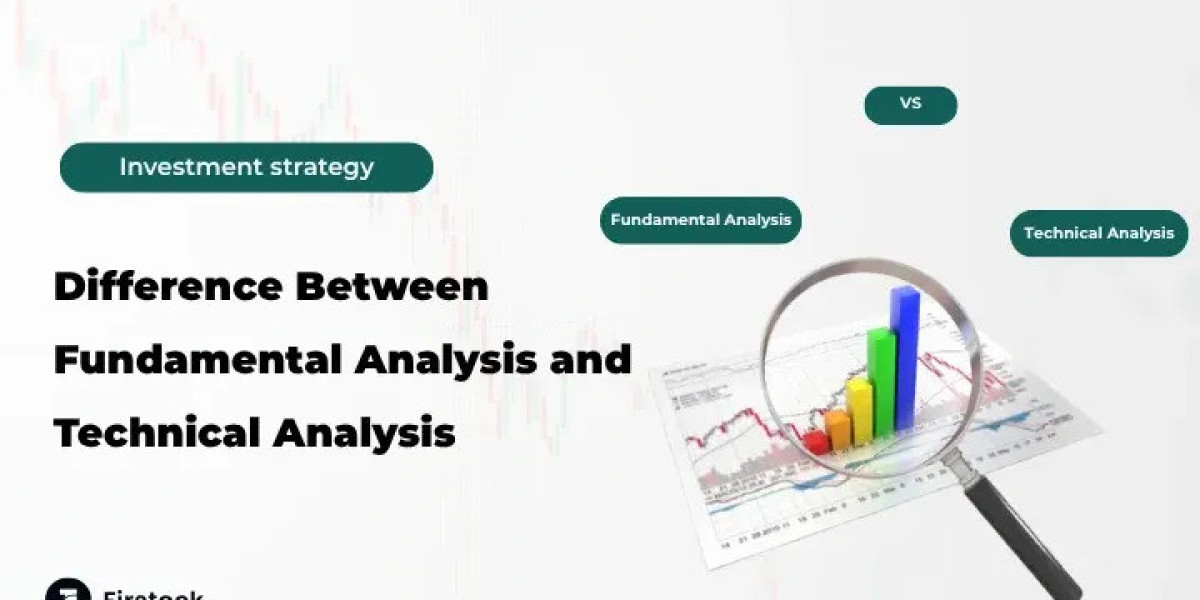Difference Between Fundamental Analysis and Technical Analysis
Introduction
If you’ve ever wondered how investors decide which stocks to buy or sell, you’re not alone. Some people study company balance sheets and economic trends, while others stare at charts filled with colorful lines and patterns. These two worlds represent Fundamental Analysis and Technical Analysis — the two main pillars of stock market research.
Think of it like this: if investing were like buying a car, fundamental analysis would be like checking the engine, mileage, and build quality — understanding what’s under the hood. Technical analysis, on the other hand, would be like watching how the car moves on the road — studying speed, curves, and patterns.
In this article, we’ll break down the difference between fundamental analysis and technical analysis, explore their uses, and show how you can apply both while trading using the best trading apps in India, discount brokers, and stock brokers in India.
Discover the difference between fundamental analysis and technical analysis. Learn how fundamental analysis of stocks and technical analysis of stocks help investors using trading apps in India, discount brokers in India, and top stock brokers in India.
What is Fundamental Analysis?
Fundamental analysis focuses on determining a stock’s true or intrinsic value. It involves studying financial statements, business models, management quality, and economic conditions to see whether a company is undervalued or overvalued.
For example, if you analyze Tata Motors, you’d look at its profit growth, debt levels, future expansion plans, and the automobile industry’s outlook. If the company’s performance is solid but the stock price is low, it might be a good buying opportunity.
What is Technical Analysis?
Technical analysis is all about price action and patterns. Instead of studying financial reports, it uses charts and indicators to predict future price movements based on past behavior.
Traders often look at charts showing moving averages, RSI (Relative Strength Index), and MACD to spot buying or selling opportunities.
If a stock breaks its previous resistance level, it might indicate an upcoming rally. That’s why short-term traders love technical analysis — it helps them time their entry and exit precisely.
Core Difference Between Fundamental and Technical Analysis
Aspect | Fundamental Analysis | Technical Analysis |
Focus | Company’s financial health | Market price trends |
Objective | Find intrinsic value | Predict short-term movement |
Time Frame | Long-term | Short-term |
Tools | Balance sheet, P&L, ratios | Charts, indicators, patterns |
Users | Investors | Traders |
The difference between fundamental analysis and technical analysis lies in approach — one studies what to buy, the other decides when to buy.
Objectives of Each Analysis Type
Fundamental Analysis: To determine whether a stock is worth investing in based on its real value.
Technical Analysis: To identify the best time to enter or exit a trade by reading market signals.
Simply put, investors rely on fundamentals, while traders focus on technicals.
Tools Used in Fundamental Analysis
Fundamental analysts dig into a company’s numbers. The main tools they use include:
Financial Statements: Income statement, balance sheet, and cash flow.
Financial Ratios: Price-to-Earnings (P/E), Return on Equity (ROE), Debt-to-Equity ratio.
Industry Comparison: Benchmarking against competitors.
Economic Indicators: GDP growth, inflation, interest rates.
These tools help determine whether a company is growing sustainably.
Tools Used in Technical Analysis
Technical analysts rely on graphical tools and mathematical indicators such as:
Candlestick Charts: Visual representation of price movements.
Moving Averages (MA): To smooth price data and identify trends.
Relative Strength Index (RSI): Shows if a stock is overbought or oversold.
MACD (Moving Average Convergence Divergence): Reveals trend changes.
Support and Resistance Levels: Indicate potential turning points in price.
These help traders make quick, data-driven decisions.
Time Horizon: Long-Term vs Short-Term Investing
Fundamental analysis is ideal for long-term investors who believe in “buy and hold.” They focus on the company’s potential over years.
Technical analysis suits short-term traders — those who want to profit from daily or weekly price movements.
Think of it like gardening: fundamental analysts plant a tree and wait for it to grow, while technical traders pick ripe fruits daily.
Data Sources: Where Do Analysts Get Their Information?
Fundamental Data: Comes from company reports, government statistics, and economic research.
Technical Data: Comes from stock prices, volumes, and chart patterns.
Today, most of this data is easily available on trading apps in India, making analysis simpler even for beginners.
Example: How an Investor Uses Both Analyses
Let’s say you want to invest in Infosys.
Fundamental Analysis: You check its revenue growth, profit margin, and client portfolio. Everything looks strong.
Technical Analysis: You see that the stock just broke out from a resistance level — a bullish sign.
By combining both, you not only pick a good company but also time your entry perfectly.
Fundamental Analysis of Stocks – Key Metrics
When conducting fundamental analysis of stocks, focus on:
Earnings Per Share (EPS): Indicates profitability.
P/E Ratio: Compares price to earnings.
Book Value: Reflects the company’s total worth.
Dividend Yield: Shows how much return you get from dividends.
Debt-to-Equity: Reveals financial stability.
Studying these metrics helps identify strong companies that can perform well over time.
Technical Analysis of Stocks – Popular Indicators
For technical analysis of stocks, traders often use:
Bollinger Bands: Measure volatility.
Volume Analysis: Higher volume confirms price trends.
Fibonacci Retracement: Identifies possible reversal points.
Candlestick Patterns: Such as Doji, Hammer, or Engulfing.
Learning to interpret these indicators gives traders a competitive edge.
Which Analysis Suits You as an Investor?
If you’re someone who enjoys researching businesses, reading annual reports, and holding stocks for years — go for fundamental analysis.
If you prefer fast decisions, quick profits, and love charts — technical analysis is your zone.
Some investors use both. For example, they select stocks based on fundamentals but decide when to buy or sell based on technical signals.
How Trading Apps in India Make Analysis Easier
With the rise of technology, trading apps in India like Paytm Money, Upstox, and Angel One have made both analyses accessible to everyone.
You can view financial statements, P/E ratios, and company news for fundamental analysis.
At the same time, you can analyze charts, indicators, and live data for technical analysis — all in one place.
Role of Discount Brokers in India
Discount brokers in India like Rupeezy, Shoonya by Finvasia, and BlinkX by JM Financial offer low-cost trading with access to advanced analytical tools.
They don’t provide full research reports like traditional brokers, but they give you direct market access with minimal brokerage — perfect for self-directed investors.
Choosing the Right Stock Broker in India
When selecting among stock brokers in India, consider:
Brokerage Charges: Lower costs mean better net returns.
Platform Features: Real-time data, charts, and reports.
Customer Support: Quick assistance is crucial.
Regulatory Compliance: Ensure SEBI registration.
Top stock brokers like ICICI Direct, Kotak Securities, Motilal Oswal, and Axis Direct cater to both investors and traders with balanced offerings.
Final Thoughts: Combining Both Analyses for Success
The real magic happens when you blend both fundamental and technical analysis.
Use fundamentals to choose solid companies and technicals to find the best entry and exit points. This approach helps minimize risk and maximize returns.
Whether you’re using a trading app in India or a discount broker, mastering both methods will empower you to make smarter investment decisions.
FAQs
1. What is the main difference between fundamental analysis and technical analysis?
Fundamental analysis studies a company’s financial health, while technical analysis focuses on price patterns and market behavior.
2. Which is better for beginners — fundamental or technical analysis?
Beginners often start with fundamental analysis to understand company basics before exploring technical tools for timing trades.
3. Can I use both analyses together?
Yes! Many successful investors combine both. Fundamentals help you find quality stocks, while technicals help you time your trades.
4. Do trading apps in India support both types of analysis?
Absolutely. Most modern trading apps in India provide financial data, charts, and indicators for both analyses.
5. Are discount brokers in India suitable for beginners?
Yes, because they offer low-cost trading and access to analytical tools, making them perfect for learning and experimenting.
Conclusion
Understanding the difference between fundamental analysis and technical analysis helps you see the stock market through two powerful lenses. One shows the true value of a company; the other shows how the market reacts.
By combining them — and using the right trading apps, discount brokers, and stock brokers in India — you can confidently navigate the world of investing and trading with clarity and purpose.










